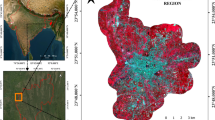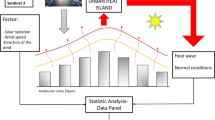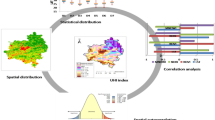Abstract
The increasing frequency of heat waves (HW) in many parts of the world is emerging as one of the climatic vulnerabilities across the world resulting in elevated thermal stress and high mortality. With increase in HW intensity, frequency and duration at global level, India has seen several major HW events in the last decade. HW conditions have mostly been studied by analysing ground-based observations; however, this approach lacks information on spatial variability at the local scale, which is not adequate to identify HW risk and vulnerability hotspots. In this study, gridded analysis of spatio-temporal variability of HW indices has been carried out by utilising freely available Moderate Resolution Imaging Spectrometer (MODIS) Land Surface Temperature (LST) data on Google Earth Engine (GEE) platform in the Indo-Gangetic Plains of India. HW indices to analyse duration, frequency and intensity of HW have been identified and further computed on a grid size of 10 km*10 km area. HW risk and vulnerability hotspot in the study region have been identified by spatial modelling of HW indices, LULC change and population density. The HW risk and vulnerability hotspot layer identified NCT Delhi and its surrounding region at the highest risk of HW with high vulnerability. A strong positive correlation of variability of HW indicators with increasing built-up shows that built-up surfaces affect strongly the HW conditions.










Similar content being viewed by others
Data availability
The findings of the study were derived from the openly available dataset from following resources available in the public domain: [Aqua MODIS daily LST (https://earthengine.google.com/platform/), temporal LULC map (https://bhuvan-app1.nrsc.gov.in/thematic/thematic/index.php#), and population data from Global Human Settlement Layer (GHSL) (https://ghsl.jrc.ec.europa.eu/download.php?ds=pop)]. Derived data that support the findings of this study are available on request from the corresponding author (Gupta K.)
Code availability
Code developed as part of this study is a copyright material of the Indian Institute of Remote Sensing, ISRO, India. It can be shared to interested researchers on request by the corresponding author (Gupta K.).
References
Alexander LV, Zhang X, Peterson TC, Caesar J, Gleason B, Klein Tank AMG, Haylock M, Collins D, Trewin B, Rahimzadeh F, Tagipour A, Rupa Kumar K, Revadekar J, Griffiths G, Vincent L, Stephenson DB, Burn J, Aguilar E, Brunet M, Taylor M, New M, Zhai P, Rusticucci M, Vazquez-Aguirre JL (2006) Global observed changes in daily climate extremes of temperature and precipitation. J Geophys Res Atmos 111(5):1–22. https://doi.org/10.1029/2005JD006290
Bahi H, Rhinane H, Bensalmia A (2016) Contribution of MODIS satellite image to estimate the daily air temperature in the Casablanca City, Morocco. Int Arch Photogramm Remote Sens Spat Inf Sci - ISPRS Arch 42(2W1):3–11. https://doi.org/10.5194/isprs-archives-XLII-2-W1-3-2016
Balan R, Rao P, Gupta K, Roy A. (2020) Open source Google Earth Platform for computation of heat wave indicators, FOSS4G Korea 2020, 12–13 November, 2020, Seoul, Korea, Retrieved from https://foss4g.osgeo.kr/slides/english01/PriyankaRao_FOSS4G_Korea_2020.pdf. Accessed 21 Jun 2021
Barriopedro D, Fischer EM, Luterbacher J, Trigo RM, García-Herrera R (2011) The hot summer of 2010: redrawing the temperature record map of Europe. Science 332(6026):220–224. https://doi.org/10.1126/science.1201224
Chakraborty S, Kant Y, Bharath B. (2014) Study of land surface temperature in Delhi City to manage the thermal effect on urban developments. International Journal of Advanced Scientific and Technical Research, 1(4), 439–450. Retrieved from http://www.rspublication.com/ijst/index.html%0AIssue. Accessed 14 May 2021
Christidis N, Stott PA, Brown SJ (2011) The role of human activity in the recent warming of extremely warm daytime temperatures. J Clim 24(7):1922–1930. https://doi.org/10.1175/2011JCLI4150.1
Conti S, Meli P, Minelli G, Solimini R, Toccaceli V, Vichi M, Beltrano MC, Perini L (2005) Epidemiologic study of mortality during summer 2003 in Italian regional capitals: Results of a rapid survey. Extreme Weather Events and Public Health Responses 109–120. https://doi.org/10.1007/3-540-28862-7_11
Darryn M, Iftekhar A, Jane M (2012) The impact of the 2009 heat wave on Melbourne’s critical infrastructure. Local Environ 17(8):783–796. https://doi.org/10.1080/13549839.2012.678320
Eckstein D, Kunzel V, Schafer L, Winges M. (2019) Global climate risk index 2020. In J. Chapman-Rose & J. Longwitz (Eds.), Berlin: Germanwatch. Retrieved from www.germanwatch.org/en/cri. Accessed 20 Jul 2020
Frich P, Alexander LV, Della-Marta P, Gleason B, Haylock M, Tank Klein AMG, Peterson T (2002) Observed coherent changes in climatic extremes during the second half of the twentieth century. Clim Res 19(3):193–212. https://doi.org/10.3354/cr019193
Ghosh S (2020) India’s hot climate got hotter in the past decade. Retrieved from https://qz.com/india/1819028/indias-hot-climate-got-hotter-in-the-past-decade/. Accessed 10 Oct 2020
Good EJ, Ghent DJ, Bulgin CE, Remedios JJ (2017) A spatiotemporal analysis of the relationship between near-surface air temperature and satellite land surface temperatures using 17 years of data from the ATSR series. Journal of Geophysical Research: Atmospheres 122(17):9185–9210. https://doi.org/10.1002/2017JD026880
IMD (2019) Statement on climate of India during 2019: temperatures. In Ministry of Earth Sciences. Retrieved from https://public.wmo.int/en/resources/library/wmo-provisional-statement-state-of-global-climate-2019. Accessed 10 Oct 2020
Intergovernmental Panel on Climate Change. (2007). Climate change 2007 impacts, adaptation and vulnerability. In (Cambridge University Press Ed.). UK. https://doi.org/10.1029/93JC02439
Kawashima S, Ishida T, Minomura M, Miwa T (2000) Relations between surface temperature and air temperature on a local scale during winter nights. J Appl Meteorol 39(9):1570–1579. https://doi.org/10.1175/1520-0450(2000)039%3c1570:RBSTAA%3e2.0.CO;2
Khandelwal S, Goyal R, Kaul N, Mathew A (2018) Assessment of land surface temperature variation due to change in elevation of area surrounding Jaipur, India. Egypt J Remote Sens Space Sci 21(1):87–94. https://doi.org/10.1016/j.ejrs.2017.01.005
Khan N, Shahid S, Ismail T, Ahmed K, Nawaz N (2019) Trends in heat wave related indices in Pakistan. Stoch Environ Res Risk Assess 33(1):287–302. https://doi.org/10.1007/s00477-018-1605-2
Lee, Y. Y., Md Din, M. F., Ponraj, M., Noor, Z. Z., Iwao, K., & Chelliapan, S. (2017). Overview of urban heat island (UHI) phenomenon towards human thermal comfort. Environ Eng Manag J 16(9):2097–2112. https://doi.org/10.30638/eemj.2017.217
Luo L, Zhang Y (2012) Did we see the 2011 summer heat wave coming? Geophys Res Lett 39(9):1–5. https://doi.org/10.1029/2012GL05138
Majumdar A, Kingra PK, Setia R, Singh SP, Pateriya B (2019) Influence of land use/land cover changes on surface temperature and its effect on crop yield in different agro-climatic regions of Indian Punjab. Geocarto Int. https://doi.org/10.1080/10106049.2018.1520927
Mandal DK, Mandal C, Singh SK (2016) Delineating agro-ecological regions. National Bureau of Soil Survey and Land Use Planning, 1–8. https://www.nbsslup.in/assets/uploads/clinks/DelineatingAgro-EcologicalRegions.pdf. Accessed 10 Jun 2021
Mazdiyasni O, Sadegh M, Chiang F, AghaKouchak A (2019) Heat wave Intensity Duration Frequency Curve: A multivariate approach for hazard and attribution analysis. In Scientific Reports (Vol. 9). https://doi.org/10.1038/s41598-019-50643-w
Meehl GA, Tebaldi C (2004) More intense, more frequent, and longer lasting heat waves in the 21st century. Science 305(5686):994–997. https://doi.org/10.1126/science.1098704
Miralles DG, Gentine P, Seneviratne SI, Teuling AJ (2019) Land–atmospheric feedbacks during droughts and heatwaves: state of the science and current challenges. Ann N Y Acad Sci 1436(1):19–35. https://doi.org/10.1111/nyas.13912
Mishra V, Mukherjee S, Kumar R, Stone DA (2017) Heat wave exposure in India in current, 1.5 °c, and 2.0 °c worlds. Environ Res Lett 12(12). https://doi.org/10.1088/1748-9326/aa9388
National Remote Sensing Agency, H. (2007) National land use and land cover map** using multi-temporal AWiFS data (Issue June). Accessed on June 14, 2021 from https://bhuvan-app1.nrsc.gov.in/2dresources/thematic/LULC250/0506.pdf
National Remote Sensing Centre, H. (2010). National land use and land cover map** using multi-temporal AWiFS data. Accessed on June 14, 2021 from https://bhuvan-app1.nrsc.gov.in/2dresources/thematic/LULC250/0809.pdf
Pai DS, Nair SA, Ramanathan AN (2013) Long term climatology and trends of heat waves over India during the recent 50 years (1961–2010). Mausam, 64(4), 585–604. Retrieved from http://metnet.imd.gov.in/mausamdocs/16441_F.pdf. Accessed 20 Jul 2020
Pal JS, Eltahir EAB (2016) Future temperature in southwest Asia projected to exceed a threshold for human adaptability. Nat Clim Chang 6(2):197–200. https://doi.org/10.1038/nclimate2833
Panda DK, AghaKouchak A, Ambast SK (2017) Increasing heat waves and warm spells in India, observed from a multiaspect framework. J Geophys Res 122(7):3837–3858. https://doi.org/10.1002/2016JD026292
Papanastasiou DK, Melas D, Kambezidis HD (2014) Heat waves characteristics and their relation to air quality in Athens. Glob. Nest J 16(5):919–928. https://doi.org/10.30955/gnj.001530
Perkins SE (2011) Biases and model agreement in projections of climate extremes over the tropical Pacific. Earth Interact 15(24):1–36. https://doi.org/10.1175/2011EI395.1
Rathee G (2014) Trends of land-use change in India. In Urbanization in Asia: Governance, Infrastructure and The Environment (pp. 215–238). https://doi.org/10.1007/978-81-322-1638-4_13
Rodgers WA, Panwar SH (1988) Planning a wildlife protected area network in India. FAO Accession No: XF9093847, FAO/Wildlife Institute of India, Dehradun India
Rohini P, Rajeevan M, Srivastava AK (2016) On the Variability and Increasing Trends of Heat Waves over India. Scientific Reports, 6(June). https://doi.org/10.1038/srep26153
Roy S, Byrne J, Pickering C (2012) A systematic quantitative review of urban tree benefits, costs, and assessment methods across cities in different climatic zones. Urban For Urban Green 11(4):351–363. https://doi.org/10.1016/j.ufug.2012.06.006
Seneviratne SI, Nicholls N, Easterling D, Goodess CM, Kanae S, Kossin J, Luo Y, Marengo J, Mclnnes K, Rahimi M, Rahimi M, Reichstein M, Sorteberg A, Vera C, Zhang X (2012) Changes in climate extremes and their impacts on the natural physical environment. In Managing the Risks of Extreme Events and Disasters to Advance Climate Change Adaptation (pp. 109–230).
Shafiei Shiva J, Chandler DG, Kunkel KE (2019) Localized Changes in Heat Wave Properties Across the United States. Earth’s Future 7(3):300–319. https://doi.org/10.1029/2018EF001085
Shelestov A, Lavreniuk M, Kussul N, Novikov A, Skakun S (2017) Exploring Google Earth Engine platform for big data processing: classification of multi-temporal satellite imagery for crop map**. Front Earth Sci 5(February):1–10. https://doi.org/10.3389/feart.2017.00017
Singh P, Verma P (2017) Impact of land use change and urbanization on urban heat island in Lucknow City, Central India. A remote sensing based estimate. Sustainable Cities and Society. https://doi.org/10.1016/j.scs.2017.02.018
Steeneveld GJ, Koopmans S, Heusinkveld BG, Van Hove LWA, Holtslag AAM (2011) Quantifying urban heat island effects and human comfort for cities of variable size and urban morphology in the Netherlands. J Geophys Res Atmos 116(20):1–14. https://doi.org/10.1029/2011JD015988
WMO (2011) Provisional statement on the status of the global climate. Retrieved from http://www.wmo.int/pages/mediacentre/press_releases/gcs_2011_en.html. Accessed 20 Jul 2020
WMO (2018) Guidelines on the defintion and monitoring of extreme weather and climate events. Retrieved from http://www.wmo.int/pages/prog/wcp/ccl/documents/GUIDELINESONTHEDEFINTIONANDMONITORINGOFEXTREMEWEATHERANDCLIMATEEVENTS_09032018.pdf. Accessed 20 Jul 2020
Acknowledgements
The authors are thankful to Director IIRS and Chairman ISRO for the encouragement and facilitating the work. The work has been carried out as part of the M. Tech. Dissertation work. The EO data from USGS, GHSL, Bhuvan and Google Earth Engine is acknowledged.
Author information
Authors and Affiliations
Contributions
All authors whose names appear on the submission have made substantial contributions to the conception or design of the work; the acquisition, analysis, or interpretation of data; or the creation of code used in the work. All authors agree to be accountable for all aspects of the work in ensuring that questions related to the accuracy or integrity of any part of the work are appropriately investigated and resolved.
Corresponding author
Ethics declarations
Ethics approval
The work is carried out at the Indian Institute of Remote Sensing/ISRO, Dehradun, as part of ongoing research. All datasets used in this study area available in public domain from the following resources: Aqua MODIS daily LST (https://earthengine.google.com/platform/), temporal LULC map (https://bhuvan-app1.nrsc.gov.in/thematic/thematic/index.php#) and population data from Global Human Settlement Layer (GHSL) (https://ghsl.jrc.ec.europa.eu/download.php?ds=pop). All the research articles has been cited appropriately in the manuscript as per the defined style and format.
Consent to participate
Consent to participate is not applicable for this study and it is entirely based on analysis of spatial data and does not include any human or live participants.
Consent for publication
Consent for publication is not applicable as no human or live participant has been utilised to carry out this study.
Conflict of interest
The authors declare no competing interests.
Additional information
Publisher's note
Springer Nature remains neutral with regard to jurisdictional claims in published maps and institutional affiliations.
Rights and permissions
About this article
Cite this article
Rao, P., Gupta, K., Roy, A. et al. Spatio-temporal analysis of land surface temperature for identification of heat wave risk and vulnerability hotspots in Indo-Gangetic Plains of India. Theor Appl Climatol 146, 567–582 (2021). https://doi.org/10.1007/s00704-021-03756-0
Received:
Accepted:
Published:
Issue Date:
DOI: https://doi.org/10.1007/s00704-021-03756-0





